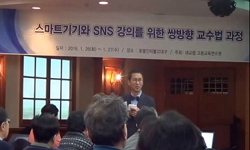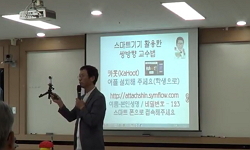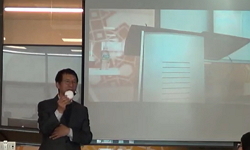50년대 말 문학 비평가로 출발했던 이 어령은 70년대 이후 자신의 초기 비평관과 연장선상에 있는 문학연구방법론 즉, 구조주의, 해체주의, 기호학 등의 학문 탐구에 전념하다가 마침내 문명(...
http://chineseinput.net/에서 pinyin(병음)방식으로 중국어를 변환할 수 있습니다.
변환된 중국어를 복사하여 사용하시면 됩니다.
- 中文 을 입력하시려면 zhongwen을 입력하시고 space를누르시면됩니다.
- 北京 을 입력하시려면 beijing을 입력하시고 space를 누르시면 됩니다.
https://www.riss.kr/link?id=A108663055
- 저자
- 발행기관
- 학술지명
- 권호사항
-
발행연도
2023
-
작성언어
-
-
주제어
융회통 ; 圓融會通 ; 쌍방향 ; 디지로그 ; 이항대립 ; 총체적 진실 ; Mash Up ; Bilateral View ; Parallelism ; Binary Opposition ; Intermediator ; Literary Criticism ; Whole Truth ; Partial Truth ; Interface ; Engagement ; AI ; Linear Form ; Spatial Form ; Digilog ; Mimesis ; Semiosis
-
KDC
900
-
등재정보
KCI등재
-
자료형태
학술저널
- 발행기관 URL
-
수록면
273-300(28쪽)
- DOI식별코드
- 제공처
-
0
상세조회 -
0
다운로드
부가정보
국문 초록 (Abstract)
50년대 말 문학 비평가로 출발했던 이 어령은 70년대 이후 자신의 초기 비평관과 연장선상에 있는 문학연구방법론 즉, 구조주의, 해체주의, 기호학 등의 학문 탐구에 전념하다가 마침내 문명(문화) 비평가로 생을 마친다 만년에 들어 그가 문명비평론에서 보여준 세계관의 원리는 다음과 같다.
① 이 세계를 단일방향이 아니라 쌍방향적 시점으로 바라보아야 한다는 것.
② 이 쌍방향의 원리는 단순한 이항 대립의 경계 허물기나 해체 그자체로 끝나는 것이 아니라 다시 새롭게 융합하여 제 3지대를 탄생시켜야 한다는 것.
③ 이 세계를 원의 원리로 보아야 한다는 것 등이다. 그러나 이 세 가지 명제의 기저를 이루는 그의 문명관은 그가 초기의 문학비평에서 보여주었던 정신세계와 동떨어진 것이 아니다. 오히려 시에 대한 그의 깊이 있는 통찰 혹은 시적 사유에서 생성된 것이라고 할 수 있다.
우선 ①의 명제가 그렇다. 보편적으로 시학에서는 시의 본질을 해명하는 이론의 하나로 병렬(parallelism)이라는 개념이 있는데 이어령이 주장한 그 “쌍방향의 시점”이라는 것이 이와 맞아 떨어지기 때문이다. 병렬이란 시적 진술 내지 상상력이 일방적, 선조적(線條的linear form)으로 전개되지 않고 쌍방적, 공간적(spatial form)으로 배열 혹은 병치시키는 구조를 말한다. 여기에는 등가적(等價的equivalent)인 것과 대조적(opposite)인 것이 있지만 이 중 후자는 이어령이 말하는 쌍방향의 시점과 거의 일치하는 것이라고 말해도 무리가 없을 듯하다. 리차즈도 시의 본질은 서로 대립되는 두 가지의 가치 혹은 정서적 충동들(opposite impulsees)의 통합에 있다 하여 이 중 어느 하나를 배제해서(exclusive) 만드는 방식이 아닌, 이 두 가지를 내포(inclusive)시켜 ‘조화(reconciliation)’ 혹은 ‘균형(equilibrium)’을 이루는 방식이 보다 훌륭하다고 말한 바 있다.
②의 명제에서 매개항 혹은 중간항이 이항 대립의 경계를 해체시켜 새로운 제 3의 가치를 창출해야 된다는 이어령의 문명관은 구조주의 시학에 일반화되어 있는, 시란 그 중심을 이루는 두 상상력의 이항대립(binary opposition)이 매개항(intermediator)에 의해 새로운 차원으로 상승되는 것이라는 이론 그대로이다.
③의 명제는 시가 이 세계를 바라보는 관점 혹은 시적 진실(poetic truth)이란 무엇인가 하는 문제와 관련된다. 즉 시가 이 세계를 지시하는 의미 혹은 독자들을 깨우치는 진실이란 무엇이냐 하는 것인데 이는 달리 말해 산문적 진실과 다른 어떤 특별한 시적 진실에 관한 질문이기도 하다. 그것은 한마디로 산문적 진실은 ‘부분적 진실(partial truth)’이고 시적 진실은 ‘총체적 진실(whole truth)’이라는 사실에서 해명될 수 있다.
총체적 진실이란 무엇인가. 본론에 관련된 측면만을 들어 이야기 하자면 다음과 같다. 우리들은 진리를 으레 논리적인 것으로만 생각하기 쉽다. 진리란 항상 과학에 토대해야 된다는 편견을 가지고 있기 때문이다. 가령 우리는 1+1=2는 진리라 하지만 1+1=1은 진리가 아니라고 한다. 그러나 인생론적 혹은 존재론적 차원의 의미를 다루는 시적 진리는 이와 전혀 다르다. 인간의 삶 그 자체가 이미 모순으로 되어 있는 까닭이다. 가령 사과 하나에 사과 하나를 보탠다면 사과는 물론 두 개가 되어야 한다. 그러나 사과가 아니고 사람일 경우는 다르다. 사람 하나에 사람 하나를 보태면 둘이 아니라 하나가 될 수도 있기 때문이다. 사랑이나 결혼과 같은 것이 그 적절한 예일 것이다. 물론 생물학적 관점에서는 비록 결혼을 해도 부부는 항상 남편과 아내 여전히 두 사람이다. 그러나 존재론적 관점(사랑의 관점)에선 그렇지 않다. 당연히 하나다. 그런 까닭에 부부일심동체夫婦一心同體라는 말이 있지 않은가? 그러나 이 둘의 결합은 물론 항상 하나인 것만도 아니다. 그들 사이에 자식이 태어나면 둘 혹은 셋이 될 수도 있다. 그런 관점에서 삶의 모든 것들은 모순으로 되어 있다. 죽음이 있음으로 삶이 있으며 만남이 있음으로 이별이 있는 것이다.
이렇듯 진리에는 과학이 관여하는 논리적인 것도 있지만 그에 반해서 시가 관여하는 모순의 것도 있다. 예컨대 한 사람이 인천에서 배를 타고 뉴욕으로 갔다고 치자. 우리는 그를 당연히 뉴욕에 갔다고만 말한다. 그것이 논리적이다. 그런데 만일 그가 목적지를 정하지 않고 ―세계를 일주한 마젤란처럼― 인천에서 무작정 동쪽으로 동쪽으로 항해를 한다면 그것은 ‘가면서 오는’ 행위일 수밖에 없다. 지구가 둥근 까닭이다. 유클리드 기하학에서도 마찬가지이지만 직선(논리)은 원(모순)의 일부이다.
이와같은 직선(부분)이 아닌 원으로서의 시적 진실은 이어령의 문명(문화) 비평의 핵심 명제라 할 주객 일체 혹은 이항대립의 융합이라는 ‘한 몸의 원리’와 일치한다. 그런 관점에서 이어령이 문명(문화)비평론에서 보여준 중심적 사유 혹은 상상의 세계는 한마디로 시적 사유에서 비롯하는 것이라 할 수 있다. 넓은 의미에서 이어령은 이처럼 그 시작도 끝도 본질적으로는 한 사람의 크나 큰 시인이었다.
다국어 초록 (Multilingual Abstract)
Lee Eo-ryoung started his literary career as a literary critic in the late 1950s and after the 1970s he concentrated on the methodology of literary studies, that is structuralism, deconstruction, semiotics and so on, which was the continued base of hi...
Lee Eo-ryoung started his literary career as a literary critic in the late 1950s and after the 1970s he concentrated on the methodology of literary studies, that is structuralism, deconstruction, semiotics and so on, which was the continued base of his earlier period, and finally ended up his life as a critic of civilization (culture). The principles of his world vision shown in his criticism of civilization at the late period were like this.
① We should see the world not from a unilateral way but a bilateral way.
② This principle of bilateral way should not end as a simple destruction of binary opposition or deconstruction itself but should create a third realm by new amalgamations.
③ We should see the world as a principle of a circle.
But his view of civilization based on these 3 propositions is not separated from his spiritual world shown in his early period of literary criticism. Rather, this is generated from his deep insight on poetry or his poetic thinking.
Firstly, the proposition ① is like that. Universally in poetics, there is the concept of parallelism as a theory of explaining the nature of poetry and this concept is well fit with his “bilateral view”. The parallelism means the structure of arrangement or juxtaposition in which poetic statement or imagination develops not as a unilateral and linear form but as a bilateral and spatial form. Here are the equivalent and the opposite parallelism, and it is reasonable to argue that the latter is almost the same as the bilateral view of his. I. A. Richards also said that the nature of poetry is in the synthesis of two opposing values or opposite impulses and it is better not to exclude one of them but to include the two and accomplish a new state of reconciliation or equilibrium.
Lee, Eo-ryoung’s view of civilization in the proposition ② that a medium or an intermediator should create a third value by deconstructing the border of the binary opposition is the same as the structuralist poetics in general which argues that poetry is the advance of the binary opposition or two imaginations to a new level by an intermediator.
The proposition ③ is concerned with the matters which question the poetic view of the world and the poetic truth. The question is what poetry refers to this world or with what truth poetry enlightens the readers, In other words, this is the question regarding the prosaic truth and the other specific poetic truth. In a word, the fact is that the prosaic truth is a partial truth and the poetic truth is a whole truth.
What is the whole truth? It is as following if only pointing to the main topic. It seems that we regard the truth only as a logical one because we have the prejudice that the truth should always be based on the science. For example, we say ‘1+1=2’ is true, but ‘1+1=1’ is false. But the poetic truth which deals with the meaning of the levels of the view of life and ontology is fundamentally different as human life itself is in a contradiction. If we add one apple to an apple, the apples become two. But in the case of humans, it is different. If a human is added to a human, it may be one, not two. Love or marriage will be the case. Of course, in a biological sense, a couple is two, a husband and a wife, though they got married. But in an ontological view (view of love), it is different. They are naturally one. They are one body with same minds. But the union of them is not always one. If there are children between them, it may be two or three. In these views, all thing in life consist of contradictions. For there is the death, there is the life, and for there is a meeting, there is a parting.
So there is a logical truth like science and on the other hand there is a contradictory truth like poetry. For example, if a person went to New York from Incheon by ship, we say he went to New York and this is logical. But if he moves only toward the East continuously without determining any destination - like F. Magellan who tripped around the world - it is only the activity of ‘going and simultaneously coming’ because the earth is round. Also in Euclidian geometry, the line (logic) is the part of a circle (contradiction).
This concept of poetic truth not as a line (the part) but as a circle (the whole) accords with Lee, Eo-ryung’s concept of the unity of subject and object or the amalgamation of binary oppositions which is ‘the principle of one body’, the core proposition of his criticism of civilization (culture). In this point, it can be said that the central or imaginary world he has shown in his criticism of civilization (culture) is drawn in a word from the poetic thought. In a larger sense, like this, Lee, Eo-ryoung was in nature a great poet in his beginning and end.
동일학술지(권/호) 다른 논문
-
- 영산대학교 동양문화연구원
- 이형성 ( Lee Hyung-sung )
- 2023
- KCI등재
-
- 영산대학교 동양문화연구원
- 임형석 ( Lim Heng-seok )
- 2023
- KCI등재
-
- 영산대학교 동양문화연구원
- 송혜영 ( Song Hyea-yeong )
- 2023
- KCI등재
-
전북 <홍수전설>의 전승양상과 인문지리적인 지역적 특수성 ― 비(非)창세신화계를 중심으로 ―
- 영산대학교 동양문화연구원
- 권도경 ( Do Kyung Kwon )
- 2023
- KCI등재





 KCI
KCI KISS
KISS






